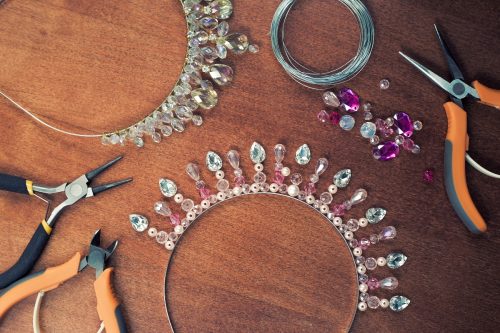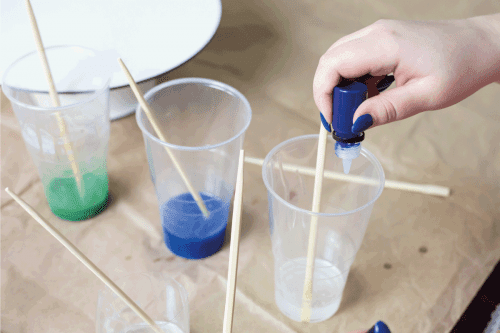So you've been considering starting a new hobby. You really enjoy crochet and knitting, and you're really hoping to up your textile game. However, from what you've gleaned, weaving can require some specialized equipment and expensive materials. You'd love to try it without breaking the bank. Is weaving an expensive hobby? We've done some digging and have the information for you.
Weaving does not have to be expensive. It's best to begin with smaller, less expensive equipment to decide if you really enjoy the hobby before fully investing. Weaving requires a loom, ranging from around $50 for a small tabletop variety to thousands of dollars for a large floor loom. Regarding materials, a skein of yarn, depending on the material type, is generally only a few dollars. That being said, larger projects can require a large time and monetary investment when done right.
Now that it's established, weaving doesn't have to be an expensive hobby; read on to learn the variable costs involved with the weaving hobby. Find out about different types of looms, additional tools, and weaving materials!

Looms
The most important piece of equipment to get started weaving is a loom. Looms come in a variety of shapes and sizes, from small tabletop looms to expansive floor looms. There are even looms made with specific projects in mind, generally marketed to children but useful to all ages.
Tabletop Looms
A loom that fits on your table or other small, flat surface is the best option for a beginner. Most of these beginner's looms cost less than $100, and many come in kits, including the other tools you need to get started. These are great for smaller projects, such as a scarf or small, simple tapestry. You can even fashion your own loom out of cardboard. However, we recommend starting with a wooden frame loom to avoid any additional frustration for a beginner.
View this basic frame loom on Amazon.
Tabletop looms do increase in price as they become more intricate and can be used for more detailed projects.
View this rigid-heddle loom on Amazon.
Floor Looms
The more traditional floor looms are large contraptions used for big projects like rugs or full wall tapestries. These are typically what people used centuries ago to create clothing and other textiles for the home more easily. These are highly mechanized and, once prepped, a lot quicker than using tabletop or standing looms because they have a shuttle propelled with foot pedals. These are generally several thousand dollars, a substantial investment. We recommend beginning with the less expensive variety to find out if you like weaving and expand your hobby from there!
View this floor loom on Amazon.
Tools
We mentioned above how the more you spend on the loom, the easier the weaving will be. When first starting with a simple wood frame loom, it will help to have a long, metal weaving needle.
Many beginner looms do not have a beater, which is the part of the loom that holds apart your warp (the stationary yarn stretched tight around the wood frame). The beater also presses each pass of yarn together, so lacking one makes it difficult for the shuttle to pass through the yarn. A thinner needle is handy for beginning, as well as for more intricate work.
View this weaving needle on Amazon.
Now that we've mentioned parts such as a beater (also referred to as a reed) and a shuttle, you'll want to ensure your loom comes with these pieces. If your tabletop loom doesn't come with a beater, you will need a fiber comb to press down your work. Any loom you get will have the recommended tools and instructions.
View this comb and shuttle on Amazon.
Materials
Yarn is relatively inexpensive, and the material you'll need the most for your weaving projects. Ensure the type of yarn you purchase, especially for the warp on your loom, is strong and durable. The tension has to be held for a long period of time while you complete the weaving project. It also needs to be smooth and consistent in width and texture, or it could affect your weaving's overall look. Even with those parameters, cotton yarn is affordable.
View this cotton yarn on Amazon.
If you develop in your hobby and want to weave an elaborate, detailed tapestry with the finest thread, your cost is definitely going to go up. Keep in mind, though, whatever you create would surely be less expensive than enlisting your specialty tapestry to be made by someone else!
Can You Weave Without a Loom?
You can weave without buying a loom. You can use a piece of cardboard to hold your warp and weave with the barest of materials. Understand, however, if starting with this method, it will likely take longer to get the hang of it than it would with a wooden frame loom. Cardboard simply will not hold the best tension for creating the best weave.
To make a cardboard loom, you'll need a sturdy, large piece of cardboard, a ruler or measuring tape, scissors, and a pencil. Watch this tutorial to see how:
Additionally, creating macrame is very similar to weaving. It can even be argued that making things such as friendship bracelets or necklaces is a weaving technique. If you want to start by just doing some macrame projects, you'll have a very good idea of what it feels like to weave. Macrame pretty much just requires yarn, fabric, or string to get started.
What Do you Need to Start Weaving?
To get started, you'll need a loom, shuttle, weaving needle, reed/beater or comb, yarn, and a good pair of fabric scissors.
View these fabric scissors on Amazon.
Aside from the tools, you'll want a general understanding of how weaving works and what it is. Essentially, weaving is simply interlacing at least two separate sets of yarn or thread at right angles to create cloth. Weaving is used to create an abundance of different projects, from scarves to blankets to towels or tapestries. Get the basics by watching this youtube tutorial:
What is the Best Weaving Loom for Beginners?
A basic frame loom, such as the one used in the tutorial above, is an inexpensive, straightforward beginner's option. They do leave a bit more room for user error but help to get a handle on what weaving is and the process involved. Remember, for these looms, you'll need a comb and a metal weaving needle.
View this frame loom on Amazon.
If you're sure this is a hobby you'll want to pursue, perhaps start with what is called a rigid-heddle loom. This type of loom can still be affordable, yet it is more expensive than a basic frame loom. However, this type of loom generally comes with a beater (or reed), which separates the yarn and gives a large, easy space to move the shuttle through.
View this rigid-heddle loom on Amazon.
Either of these two options is great for beginners!
If you're looking for an even simpler loom, there are beginner's looms directed toward children, but don't let that deter you if you want to give it a shot. These looms generally come with stretchy material to make squares about the size of potholders. These squares could potentially be joined together for larger creations.
Want to know about a different kind of weaving? Check out our post, "How Long Does it Take to Weave a Basket?"
Can I Make Money from Weaving?
Weaving is, overall, a hobby. With today's machinery and massed produced textiles, most choose low price over quality. That being said, you can make some money from weaving, but the potential in that lies mostly with you.
These days, even with mass-produced textiles, there is still quite a market for hand-made goods. Think of websites such as Etsy, which are lauded as indie marketplaces for small shops to sell goods. If you can market yourself and your product, there is potential for money to be made.
In addition to selling your goods, there is the potential for a weaving blog, tutorials, or teaching classes (once the hobby is mastered), all of which could be potential moneymakers.
It would be difficult to make a living on weaving alone. However, if you sell your creations, you can potentially make enough to support the weaving addiction you are sure to get once you start!
In Closing
Weaving can be an expensive hobby, but it doesn't have to be. Getting started can be done for less than fifty dollars if only the bare essentials are purchased. If you must, start with a homemade loom and build from there. Regardless of how you get started, you're sure to find a new hobby you will love. So relax, and make something beautiful!
Want to read more about different kinds of looms? Check out our post, "Is Loom Knitting Easier Than Needle Knitting?"















![Read more about the article Can You Use Hot Glue On Glass? [And How To]](https://craftsbliss.com/wp-content/uploads/2022/06/A-collaged-photo-of-a-glue-gun-and-glass-sheets-500x333.png)
